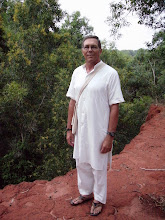 Friday, May 30, 08 (Pondy, India)
Friday, May 30, 08 (Pondy, India)Today, John is returning home to the UK from Bangkok.
Having travelled together for 9 days (April 11-20) through Malaysia, meeting first in Melaka and parting in Tanah Rata, we made plans to reconnect two weeks later in Bangkok, if our paths intersected. He went his way, crisscrossing Thailand, visiting a friend who was ailing, and I took Thailand through a different path. Staying in touch through texting, we found ourselves both in Bangkok on Sunday, May 4. (One of the oddities of such travel is finding those I have met in one location showing up in another. Anna and I crossed paths in Sumatra and found each other again in Brunei, same hostel. Allan and I travelled a short while on a bus to Penang, Malaysia and I passed him on the street in Chiang Mai, Thailand.)
Bangkok is a very large city. Where and how to find each other can only be done through knowing a simple layout of the capital. Having arrived from Lopburi on the train, I call John while riding a tuk tuk from Hualamphong Railway Station to Khao San Rd and find that he is already on his way. Khao San Rd is not long, 2 blocks, but I failed to tell John where on this road to find me. Not wanting to book a room until we can look it over together, I stand on the river side of Khao San. I've been carrying my packs for several hours and am tired. My shoulders and feet are hurting, I'm sweating in the heat, and need to find something to drink - fresh orange juice. Unloading my packs under a small tree for shade, I wait. Ten minutes drift by as I glance through the foot traffic. A kerplunk and I recognize the blue daypack thrown onto my bags. Turning, I see John on my right shoulder. A joyous greeting and a familiar face, the first one in two weeks traveling. Off to look for a room, John also finds an orange juice (These are vendors who squeeze them fresh.) and we catch up on so much. Two weeks apart, when traveling hard, is an enormous amount of time and experiences. The next day, we will retrieve my passport, with my India visa, and the following, with John's son Stewart and his girlfriend Claire, we will travel into Cambodia. Good to see John again!
It is not a rarity to find someone to travel with. But, to find someone compatible is a treasure. I have been fortunate to find good traveling companions from Anna and Shannon, to Paul and Csanad, Iain, Pat, Bill, and the longest, 17 days, with John.
-Sunsets across the Strait of Melaka.
-12 hour train and 10 hour boat rides. Others which were shorter and felt longer.
-The horrors and exquisite sublime of Choeng Ek and Angkor Wat.
-The coolness of the Cameron Highlands and the deadening heat of Ta Prohm.
-A beach to ourselves at Pantai Irama and a swim in the South China Sea.
-The humor, anger, and disgust of Poi Pet.
-Rain drenching days in Penang and dark nights in Gua Museng, with its eerie outcroppings.
-The art of looking for a room.
-Eating the best food ever all over. John knows how to eat.
-Relishing sweet/condensed milk in coffee in Penang, John expre
 ssing his pleasure by smacking his lips.
ssing his pleasure by smacking his lips.-A steamboat in Tanah Rata.
-Much laughter all along and a fine friendship.
Now, on his way home, Safe Travels!










